Every house should have an aloe vera plant if you ask me. There is no other plant that will give you so much for so little care! In this post, we’ll talk about everything that you need to know about growing aloe vera… Where you can get an aloe vera plant, how to plant aloe vera, care for the plant, how to harvest, and how to use it.
If there is one plant you should grow no matter where you are or how much space you have or don’t have, it’s Aloe Vera.
They say a dog is man’s best friend, I say it’s actually Aloe Vera. With all due respect for dogs (and I have a lot…), this plant requires almost no care, it doesn’t poop or drool, and it’s going to save you on a regular basis.
I received my aloe vera plant from my ex-mother-in-law something like 13 years ago. I planted it in a pot (we’ll talk more about that later) and to this day, I still grow that same plant.
Over the years, there were a few times that I thought that I’d lost it… Too much rain in the summer or a few times I left it outside during a very cold fall night.
Somehow, every time it comes back! I have to do very little for it to just be there by my side.
I call THAT… A very good friend!
Growing Aloe Vera…
If you don’t own an aloe vera plant yet, I hope that by the end of this post you’ll be convinced that it’s the next plant that you need to bring into your life. But for now, let’s start at the beginning…
What is Aloe Vera?
Aloe Vera is a succulent plant, meaning it stores water in its leaves (it’s 94% water). It grows up to about 36 inches tall and spreads outward by offsets or “pups” (picture below) to form a wide cluster of chubby leaves.

Aloe Vera is native to Northern Africa. The green (or grey-green) leaves are thick and fleshy with tiny white teeth on their margins. The “teeth” can scratch but are not as bad as thorns.
There are almost 300 identified species of aloe vera. Medical aloe vera can be recognized by the faint white spots on the thick leaves.
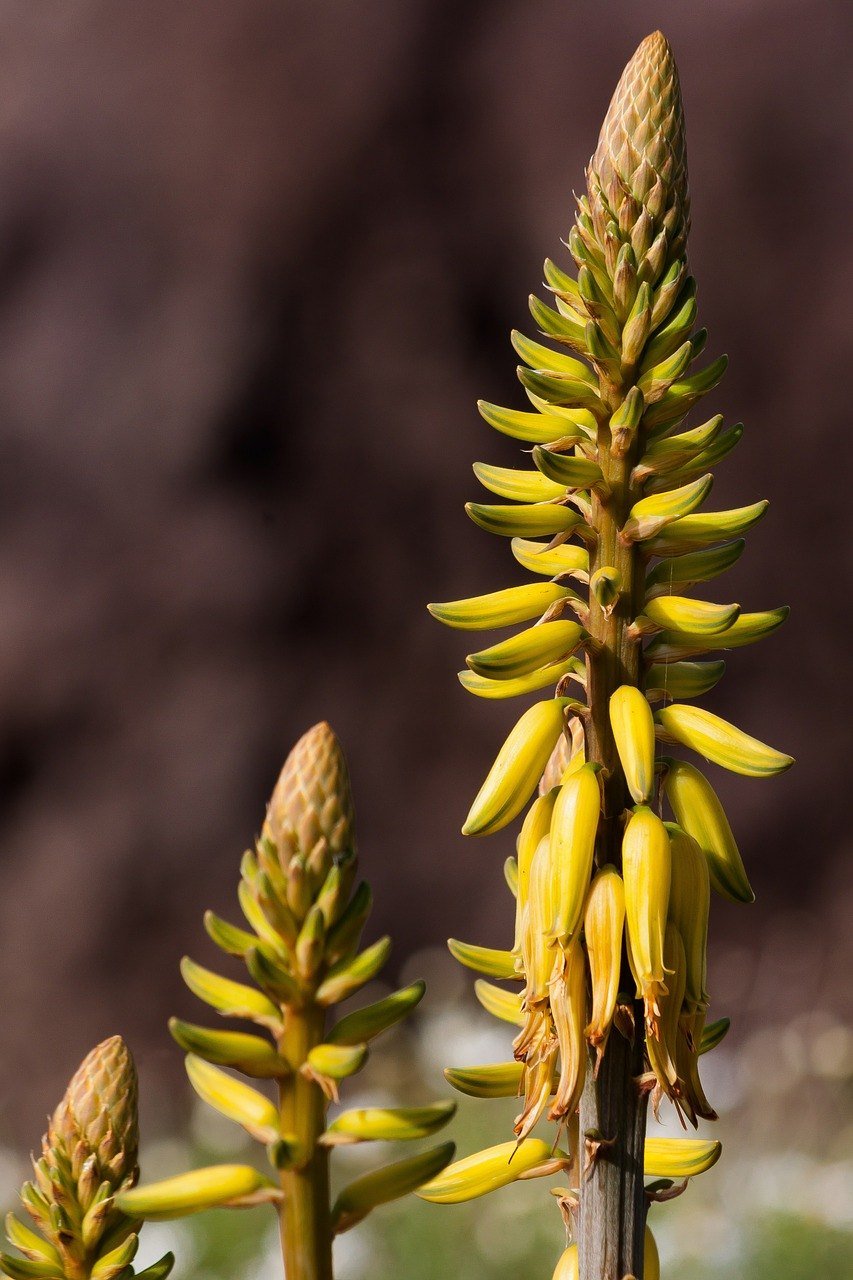
In the desert, aloe vera will produce a flower stem in the spring. It grows from the center of the plant and is 2 to 3 feet tall and topped with tubular pink or yellow flowers.
Where Can I Get an Aloe Vera Plant?
Like I said before, I got my aloe vera plant from my ex-mother-in-law after she removed some offsets from her mother plant.
If you have a friend or a family member that happens to have aloe vera growing somewhere, you can propagate it by removing an offset. I’ll explain how to do this later in this post.
Your local plant nursery should have aloe vera plants. You might even be able to find it in the farmer’s market.
And, of course, like everything else, you can find it on Amazon.
How to Plant Aloe Vera…
The only thing aloe vera doesn’t like is freezing temperatures (32F and below), so…
Outdoor – If you garden in zones 9-11 you can plant aloe vera outdoors. If you are planting more than one plant, make sure to space them 3 feet apart since your plants are going to spread outward.
Aloe vera is not picky at all when it comes to soil. As long as you have decent garden soil it will have no problem growing. If your soil is heavy clay, you can mix it up with cactus and succulent soil mix or cover it with leaf mulch.
Outdoor/Indoor – In gardening zones 1-8 you’ll have to plant your aloe vera in a container that you can move indoors before the first frost.
Again, you can use cactus and succulent potting mix or you can use a regular potting mix or even some soil from your garden.
You don’t need a very deep container since aloe vera is pretty shallow rooted. however, if you want to allow your plant to spread, make sure to choose a wide container. Also, make sure you choose a container that allows for good drainage.
Note – you might think that aloe vera can handle full sun, and it might if it’s not too hot. But in areas that experience high heat during summer days, it’s better to plant aloe vera or place the pot in a partially shaded outdoor location.
Here, in NC (zone 7b) if I leave my aloe vera in full sun in July or August (temperatures are around 90 – 100 F), it becomes brown and starts to wilt (no matter how much I water it).
This was a surprise for me because aloe vera is a succulent and should be able to handle the sun. I also see it in my home country, Israel, growing wild in full sun all the time, but for some reason, it did better for me in a half-shaded spot. Maybe it depends on the humidity.
Anyway, keep an eye on your plant and move it to half shade if it can’t handle the sun.
Indoor – Aloe Vera is a great houseplant. If you can provide it with 6 to 8 hours of bright light a day, it will be very happy staying indoors. A sunroom is a great location for an aloe vera plant or maybe a south-facing window. If there is no such location in your home, but you would like to keep your aloe vera indoors, you can supplement with grow lights.
Aloe Vera is pest-resistant, drought-tolerant, and doesn’t require any fertilizing (although it doesn’t hurt to fertilize it once a year). It’s the easiest plant in the world to care for.
Watering – I water my aloe vera plant twice a year (maybe). Here, in NC we have a lot of rain in the spring and summer, so when it’s outdoors I don’t water at all. I bring it inside at the end of October and from that time until the beginning of April I water it twice.
Removing offsets – Aloe vera grows and multiplies by growing offsets (tiny aloe vera plants that grow from the mother plant). If your pot is becoming too crowded, or if you would like to give an aloe vera plant to a friend (it’s a great gift!), you can remove some of the offsets. It is better to remove the ones from the sides of the container and not mess with the center of the plant.
Wait until the offset is at least two inches tall (five or six inches is even better). Then, to separate an offset, remove the aloe vera plant from the pot. Brush away as much soil as you can and locate the place where the offset is connected to the parent plant. Cut it off right there, the offset should have a few roots.
Replant the mother plant in its pot, it might be a good time to add new soil and refresh things a bit. Then, plant the offset in its own pot and you are done. Make sure to place the plants in a well-lit location but away from direct sun.
If your aloe vera plant is planted in the garden, you’ll have to gently dig around the offset to find where it is connected to the mother plant and disconnect it. Then, dig it out carefully and replant it.
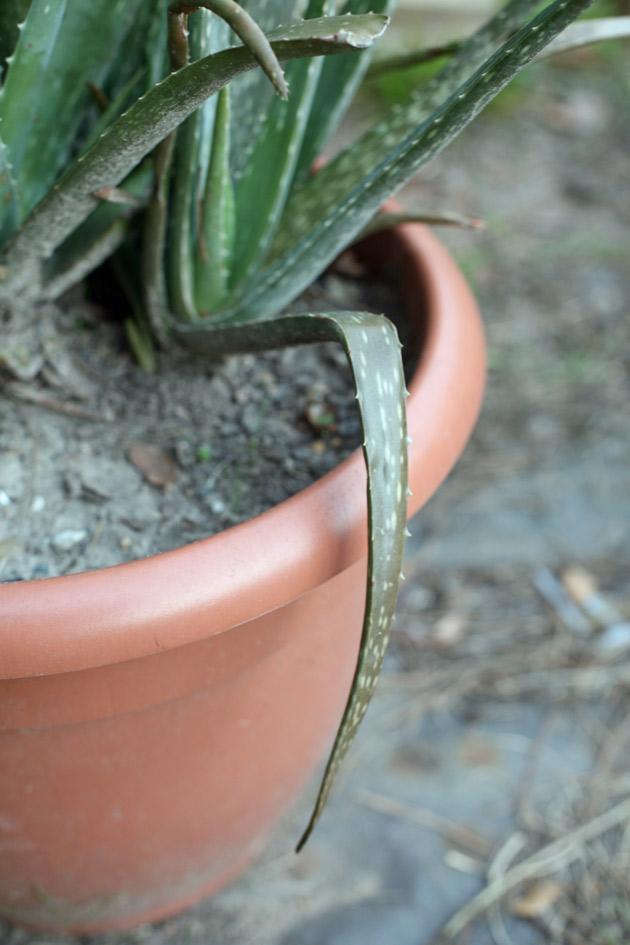
Protecting from the cold – Above you can see a leaf that is becoming brown and starting to wilt. This happened because I left my aloe vera outside when night temperatures dropped to 32F. This will also happen if you leave your aloe vera plant in full sun on very hot days.
So remember to pay attention to the weather forecast, and when it gets too cold, bring your plant indoors and place it close to a sunny window. I usually don’t wait until the frost. When night temperatures drop to the 40’s I bring my plant inside.
Aloe Vera is very forgiving, though… Even if your whole plant has wilted, it will most likely bounce right back when conditions are right. It’s very hard to kill this plant.
How to Harvest Aloe Vera…
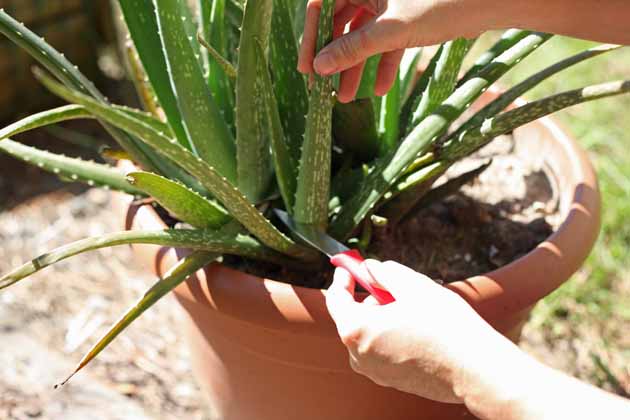
When your aloe vera plant is established and fully grown, you can start using it. To harvest aloe vera, cut one of the leaves…
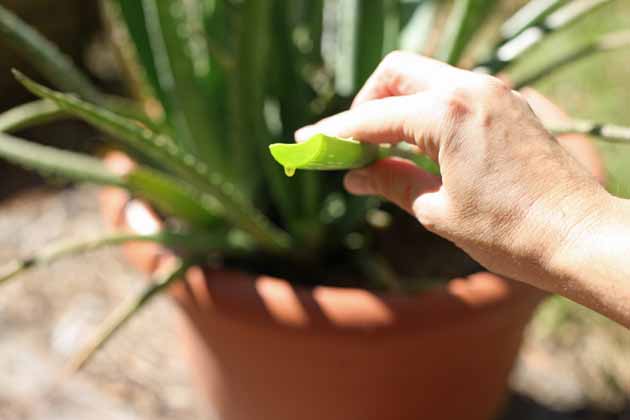
See this goodness that is coming out of the leave? This is what you want to use.
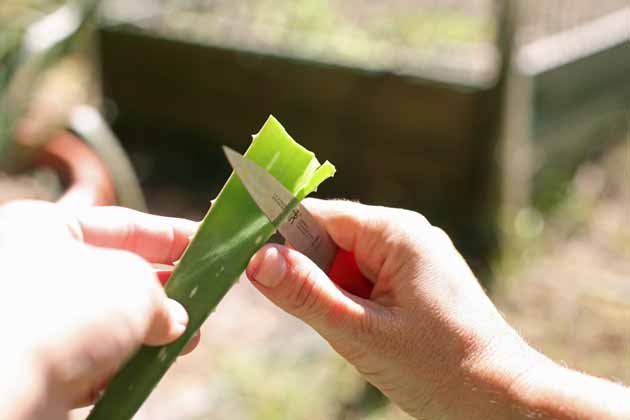
To better access the inside of the leaf cut the white teeth from one side…

Then the other…
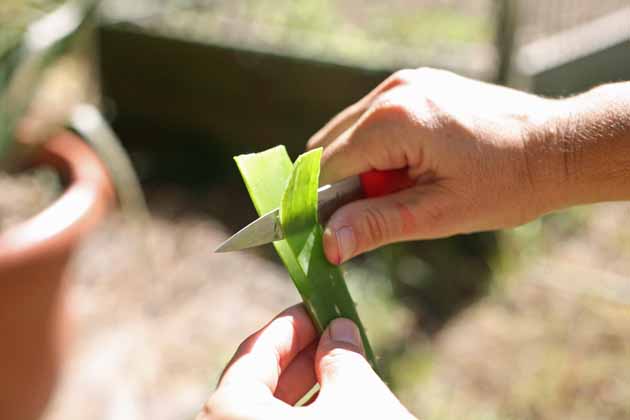
Then peel the front of the leaf off to allow you better access to the gel inside.
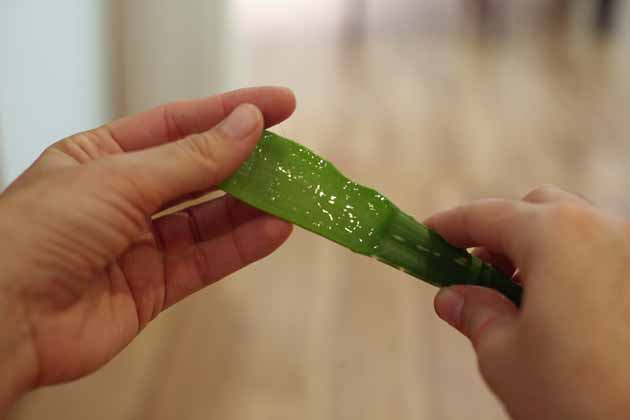
See the gel inside of the leaf? This is the part we want to use.
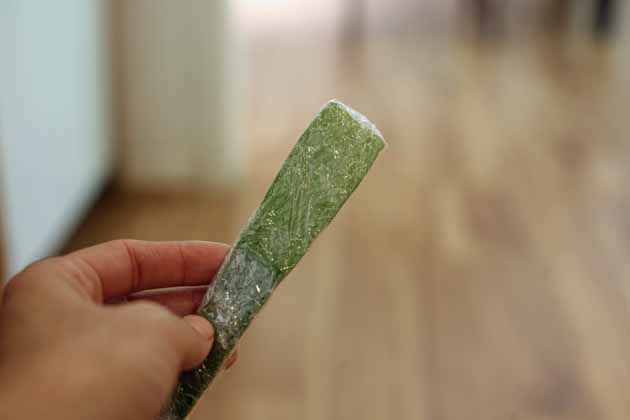
Next, we are going to talk about aloe vera uses, but just so you know, you can wrap the leaf in plastic wrap and keep it in the refrigerator for next time. When you need it again, unwrap it, peel another piece and use it. Don’t throw it away if you didn’t use all of it the first time.
Aloe Vera Uses…
The aloe vera plant produces two substances that we can use as medicine. The gel is clear and comes from the inner part of the leaf, and the latex which is yellow and is found right under the skin (you’ll notice it when you cut the leaf).
There are two main ways to use aloe vera: externally and internally.
Externally – both the gel and the latex are used externally (applying to the skin) to heal skin problems, support healthy mouth and teeth and healthy hair and scalp.
Here is a list of skin problems aloe vera can help heal by applying the gel on the skin:
Burns.
Itchy skin due to insect bites.
Sunburns.
Skin damage due to frostbite.
Athlete’s foot.
Rushes.
Blisters.
Prevent and heal acne.
Reverse wrinkles and treat signs of skin aging.
Treat eczema.
Reduce puffiness under the eyes.
Strengthen gums.
Treat hemorrhoids.
Strengthen teeth (use toothpaste with aloe vera in it).
Treat minor vaginal discomfort.
Remove makeup.
Fight dandruff by massaging into the scalp.
Internally – Aloe vera is used internally mainly by drinking aloe vera juice. To make aloe vera juice from your plant, peel a piece of leaf, so you are left with only the gel (the inner, clear part of the leaf).
Add this to a blender with a cup or two of orange juice or mango juice (or whatever else you like), blend well and drink.
Using aloe vera this way can help…
Strengthen the immune system.
Treat indigestion and constipation and support a healthy digestive system (therefore, aloe vera can help with weight loss).
Treat arthritis and relieve joint pain.
Treat heartburn.
Lower blood sugar.
Treat stomach ulcer.
Treat hemorrhoids.
Treat UTI and prostate problems.
Reduces cholesterol and supports a healthy heart.
Helps to reduce and treat inflammation and infection of the eye and ear.
Improve the look and health of the skin.
Help keep body balanced between acidity and alkalinity (aloe vera is alkaline).
Removes toxins.
Improves hair growth.
I probably forgot a few things in the list above, but you get the point. Aloe Vera is an amazing medicinal plant that has been used for thousands of years. And fortunately, it’s very easy to grow.
I keep my aloe vera in a pot so I can bring it inside to protect it from the cold but also so I can take it with me if we move. I’m not going anywhere without it!
Do you grow aloe vera? What do you use it most for?

Hi! I’m Lady Lee. I help homesteaders simplify their homesteading journey while still producing a ton of food! I am a single mother of four, I was born in Israel and raised in an agricultural commune called a Kibbutz. Now I homestead in central NC.


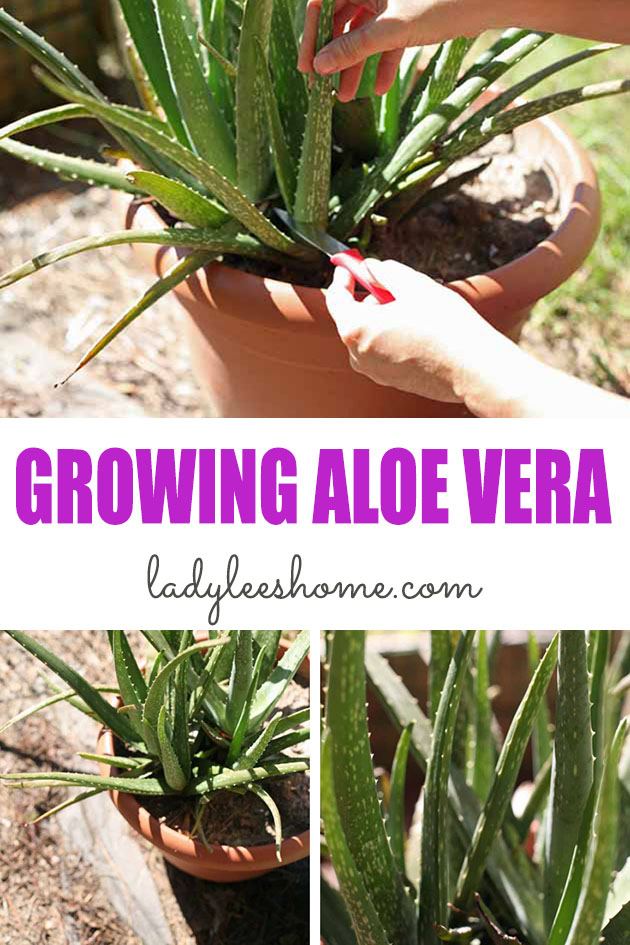

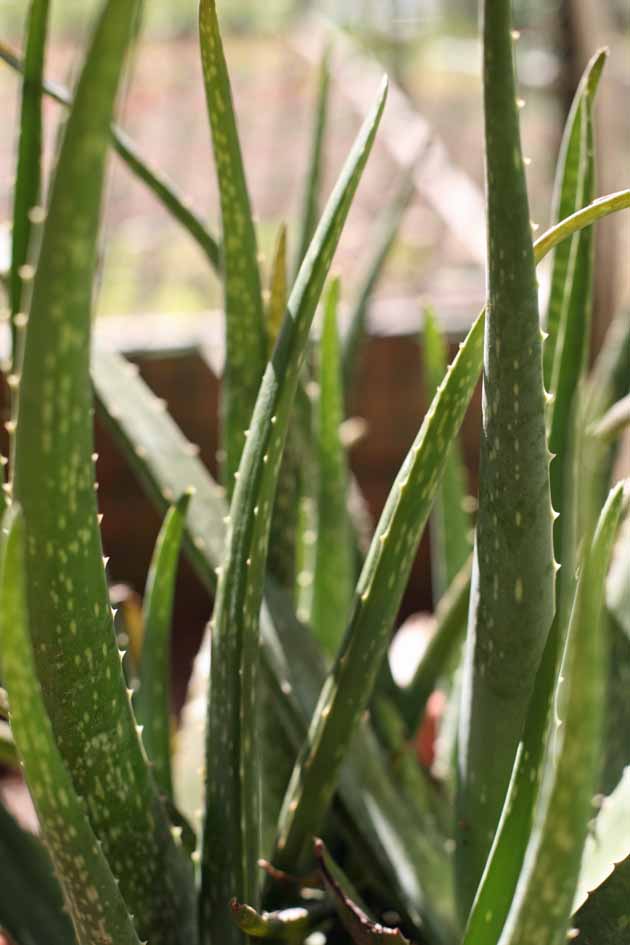
My aloe vera (2 plants actually) is getting way to tall, can I cut the top off and plan that? Or can I freeze the gel?
You can’t cut it and plant but you can cut the larger leaves, extract the gel, and keep in the fridge. It lasts for a long time.
My aloe plant looks rough. The leaves are drooping over and falling off Should I tie it up somehow?
Mine looks the same right now after the winter. It just needs more heat and sun. DOn’t tie it. Is it hot where you are? Can you take it out on the porch or in the garden so it’s in the sun?
Fantastic article! We sell our families organic aloe Vera on our website vey affordable. You also receive an adoption certificate.
About 10 years ago I bought an Aloe plant from a store that was closing. I put it next to some other house plants in my bedroom. After a while it looked like it was going to die so I just threw it in the back cellar by a window and forgot about it. One day I was looking for something or other and went into the back cellar started searching when I looked up at the shelf by the window I jumped back in fright. I seen something out of the corner of my that didn’t belong. I thought it might be a snake or something. It was the Aloe plant that had grown and sprouted to about 14″,….I was amazed. Since then I’ve cultivated hundreds. They are just great practically no care and here in Northeast Pennsylvania they thrive summer and winter with temps in my cellar from 80’s in the summer and down in the 50’s in winter. They seem to be very happy and so am I.
Great site Lee, keep up the good work.
What a great story! Thanks for sharing this. It really is a low maintenance plant!
This is such a great guide! I had an aloe vera plant that I tried to use and keep alive, but I sadly failed. I am saving this guide for down the road when I purchase another one. This is incredibly helpful! Thank you so much for sharing not only how to care for it, but also how to use this versatile plant!
Thank you, Amanda! I am happy you liked it. I love my aloe vera. I hope it will survive the winter, it really needs some sunshine…
I just read all the posts and couldn’t find how much aloe for drinking — in an 8 oz. glass? I have stomach problems and this may be the answer. Also, how do you use it on the scalp? I have psoriasis and maybe it could help. I just got a sprig of aloe from my daughter-in-law and it is hanging over the edge of the pot, not upright. It has been struggling to survive, so I’m glad to know that I may be watering it too much. Thanks for encouraging me about this plant.
It might take it a bit of time to establish and root. Just make sure it’s in a warm place. I water mine through the summer once every couple of weeks with a couple of cups of water. I think your plant is smaller so you probably need much less.
You can just spread the gell anywhere you want.
I’ll be happy to help you with your skin problems with essential oils as well. If you want to talk about that just email me to lee (at) ladyleeshome.com.
Thanks for stopping by!
Thanx for amazing information.and i wanna knw y aloe vera gel is lik water its not sticky enuf its falling lik water.mayi knw the reason for tht.thanx
It’s fine! It should be watery, only when they sell it at the store they make it into a gel so it’s easier for people to apply it.
Thanks for this informative post! You answered all of my questions. I have always kept a small aloe vera in my kitchen for burns. We recently moved from Virginia to Texas and just couldn’t bring all of our plants. My lungs have been damaged due to an autoimmune disease and a healthcare worker suggested aloe vera for the bedroom. It produces oxygen at night also scrubbing the air of benzene and formaldehyde! In Texas, the aloe vera plants are huge and of course, we are in a different zone now too. Today we hit the nursery and bought a bunch of them for inside and out. Aloe vera is such a bargain when it comes to your health.
Texas is just the place for aloe vera. Here in NC I feel like the plant is struggling sometimes. It’s too humid for it.
I hope it will help you feel better! I use the aloe vera plant mostly for skin issues. I use an essential oil blend that opens the airways and supports a healthy respiratory system at night. I put it in the diffuser right close to my head and it helps me breathe better and therefore sleep better. I’ll be happy to share more info if you are interested.
And you are right! Aloe vera has so many uses and it’s so easy to grow, it is a bargain!
Thanks for stopping by!
I live in Maryland in zone 7b, where we have lots of rain in the spring and fall. I received my aloe vera from my late mother years ago, and have given away several babies. I keep mine outdoors from April to October. I place its pot under the eaves on the sunny south side of the house, where it gets a little water but not much. After having the plant for about 7 years, it bloomed for the first time last year!
I live in NC. Same zone so same weather conditions. I do the same like you but mine never flowered yet.
Thanks for for your great explanation of Aloe Vera care & use. I am from the Tropical Islands of the South West Pacific. Vanuatu, the island of Espiritu Santo. One of the US Base during the WW2.
the Aloe Vera grows very well in most of our little islands and most people are using it as medicine as you mentioned. Yes it works
Thanks
Esrom
It does work! I love this plant. I am now visiting family in Isreal which has a dessert kind of weather and it grows here wild everywhere. It is such an amazing resource.
Thanks for stopping by.
Thank you so much for your tutorial! This was very well put together and informative! Great job! Now im off to find me a aloe plant 😉
You’ll enjoy it so much, I promise! Thanks for stopping by.
I ABSOLUTELY LOVE my aleo plant I got it off my friend who’s mother had almost 40 Huge aleo plants in the front windows of their store, these plant are over 20 years old and gorgeous, so I told him id love one for my birthday. And he gave me one, I’ve had a huge flower come out for the last 3yrs I’ve had it. One of the leaves ( I guess that’s what their called)are as long as long my arm, its awsome i get complements on it all the time.
It sounds really awesome! It is such a great plant. I am going to repot mine this year. It has been in the same pot for the last 7 years or so, I think it deserves fresh soil. Thanks for stopping by!
Hello, I want to know if the green “skin” of the aloe vera stalks can be use. and if so, how?
I don’t think you can use them… In all my research and years of growing aloe vera, I never heard of them being used for anything.
Are all types of Aloe Vera edible? I want to start eating it for health reasons and I’m not sure which type can be eaten
As far as I know, yes. But you might want to read specifically on the variety you grow.
I have read that aloe vera plants may be toxic to cats.
Have you heard this? Besides keeping the plant outdoors in the summer, do you have any suggestions for the winter months and keeping the plant seperated from cats roaming the house?
I have a cat and never had a problem with her being close to the aloe vera.
When I did the research for this post I didn’t see it mentioned anywhere. Also, animals are very smart when it comes to what they should and shouldn’t mess with. If it’s not a good plant for your cat, I am sure she will stay away.
You will have to bring the plant inside for the winter, but if you are worried about the cat, you can always keep it on a shelf somewhere in a place that is out of the cat’s way.
I live in las vegas and I must say I have to water my plants year round. But then again we are in a desert. I got my first one from a neighbor and now I have so many I don’t know what to do with them. I can’t put them in the ground because they spread too much so i have them in large pots. I notice that if i dont water them then they turn the gray color you all are talking about… so then I just over water the pot and BAMB they bounce back and before I know it more babies show up its a great way to get them to shoot off offspring. As far as flowering mine never has. Someone told me only male plants flower.. Have any of you all heard this?
uses bug bites, sunburn and added it to all kinds of smoothies and really helps with arthritis pain.
You are in a perfect location to grow Aloe vera. I didn’t know that only the males produce flowers. This explains a lot.
You should look for a farmer’s market and go a couple of days a year to sell your extra plants. Spread the aloe vera love!